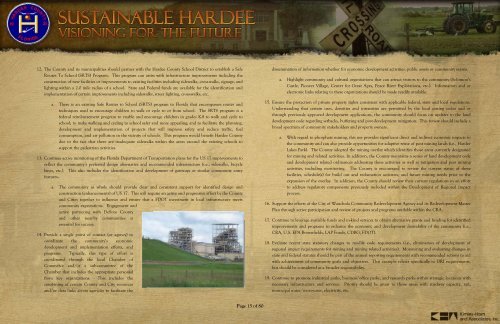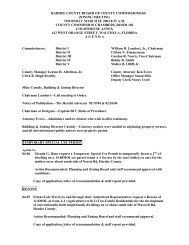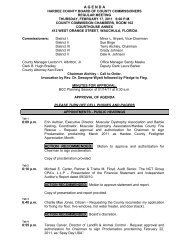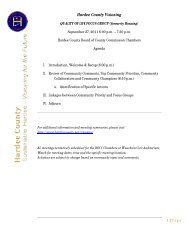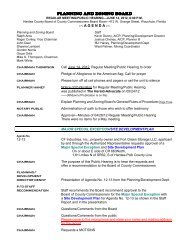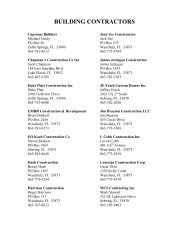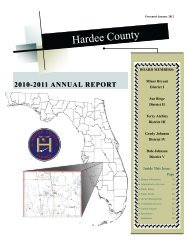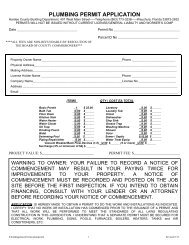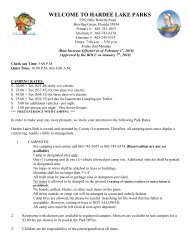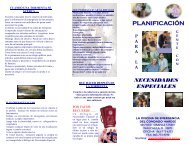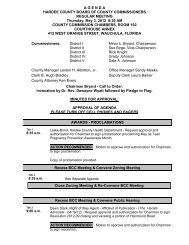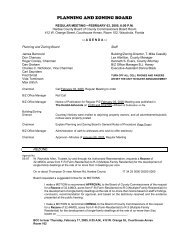FINAL Document 1/23/2013 - Hardee County
FINAL Document 1/23/2013 - Hardee County
FINAL Document 1/23/2013 - Hardee County
You also want an ePaper? Increase the reach of your titles
YUMPU automatically turns print PDFs into web optimized ePapers that Google loves.
12. The <strong>County</strong> and its municipalities should partner with the <strong>Hardee</strong> <strong>County</strong> School District to establish a Safe<br />
Routes To School (SRTS) Program. This program can assist with infrastructure improvements including the<br />
construction of new facilities or improvements to existing facilities including sidewalks, cross-walks, signage, and<br />
lighting within a 2.0 mile radius of a school. State and Federal funds are available for the identification and<br />
implementation of certain improvements including sidewalks, street lighting, cross-walks, etc.<br />
a. There is an existing Safe Routes to School (SRTS) program in Florida that encompasses routes and<br />
techniques used to encourage children to walk or cycle to or from school. The SRTS program is a<br />
federal reimbursement program to enable and encourage children in grades K-8 to walk and cycle to<br />
school; to make walking and cycling to school safer and more appealing; and to facilitate the planning,<br />
development and implementation of projects that will improve safety and reduce traffic, fuel<br />
consumption, and air pollution in the vicinity of schools. This program would benefit <strong>Hardee</strong> <strong>County</strong><br />
due to the fact that there are inadequate sidewalks within the areas around the existing schools to<br />
support the pedestrian activities.<br />
13. Continue active monitoring of the Florida Department of Transportation plans for the US 17 improvements to<br />
reflect the community’s preferred design alternative and recommended infrastructure (i.e., sidewalks, bicycle<br />
lanes, etc.). This also includes the identification and development of gateways or similar community entry<br />
features.<br />
a. The community as whole should provide clear and consistent support for identified design and<br />
construction (enhancements) of US 17. This will require an active and progressive effort by the <strong>County</strong><br />
and Cities together to influence and ensure that a FDOT investment in local infrastructure meets<br />
community expectations. Engagement and<br />
active partnering with DeSoto <strong>County</strong><br />
and other near-by communities is<br />
essential for success.<br />
14. Provide a single point of contact (or agency) to<br />
coordinate the community’s economic<br />
development and implementation efforts, and<br />
programs. Typically, this type of effort is<br />
coordinated through the local Chamber of<br />
Commerce and/or a sub-committee of the<br />
Chamber that includes the appropriate person(s)<br />
from key organizations. This includes the<br />
combining of certain <strong>County</strong> and City resources<br />
and/or data links across agencies to facilitate the<br />
dissemination of information whether for economic development activities, public assets or community events.<br />
a. Highlight community and cultural organizations that can attract visitors to the community (Solomon’s<br />
Castle, Pioneer Village, Center for Great Apes, Peace River Explorations, etc.). Information and or<br />
electronic links relating to these organizations should be made readily available.<br />
15. Ensure the protection of private property rights consistent with applicable federal, state and local regulations.<br />
Understanding that certain uses, densities and intensities are permitted by the local zoning codes and or<br />
through previously approved development applications, the community should focus on updates to the land<br />
development code regarding setbacks, buffering and post-development mitigation. This review should include a<br />
broad spectrum of community stakeholders and property owners.<br />
a. With regard to phosphate mining, this use provides significant direct and indirect economic impacts to<br />
the community and can also provide opportunities for adaptive reuse of post mining lands (i.e., <strong>Hardee</strong><br />
Lakes Park). The <strong>County</strong> adopted the mining overlay which identifies those areas currently designated<br />
for mining and related activities. In addition, the <strong>County</strong> maintains a series of land development code<br />
and development related ordinances addressing these activities as well as mitigation and post mining<br />
activities, including monitoring. The <strong>County</strong> is encouraged to review the current status of these<br />
facilities, schedule(s) for build out and reclamation activities, and future mining needs prior to the<br />
expansion of the overlay. In addition, the <strong>County</strong> should review their current regulations in an effort<br />
to address regulatory components previously included within the Development of Regional Impact<br />
process.<br />
16. Support the efforts of the City of Wauchula Community Redevelopment Agency and its Redevelopment Master<br />
Plan through active participation and review of projects and programs available within the CRA.<br />
17. Continue to leverage available funds and in-kind services to obtain alternative grants and funding for identified<br />
improvements and programs to enhance the economic and development desirability of the community (i.e.,<br />
CRA, U.S. EPA Brownfields, LAP Funds, CDBG, FDOT).<br />
18. Evaluate recent state statutory changes to modify code requirements (i.e., elimination of development of<br />
regional impact requirements for mining and mining related activities). Monitoring and evaluating changes in<br />
state and federal statutes should be part of the annual reporting requirements with recommended actions to aid<br />
with achievement of community goals and objectives. This example relates specifically to DRI requirements,<br />
but should be considered as a broader responsibility.<br />
19. Continue to promote industrial parks, business/office parks, and research parks within strategic locations with<br />
necessary infrastructure and services. Priority should be given to those areas with roadway capacity, rail,<br />
municipal water/wastewater, electricity, etc.<br />
Page 15 of 80


